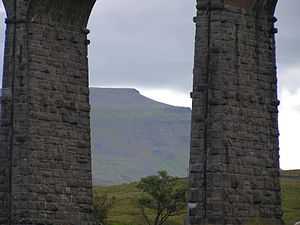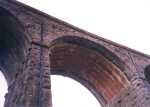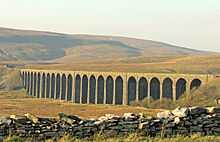Ribblehead Viaduct
 Ribblehead Viaduct |
 Ingleborough seen through an arch of the viaduct |
 Close-up of an arch of the viaduct  The Viaduct in 2014 from the west side of the line looking northwards |
The Ribblehead Viaduct or Batty Moss Viaduct carries the Settle-Carlisle Railway across Batty Moss in the valley of the River Ribble at Ribblehead, in North Yorkshire, England. The viaduct, built by the Midland Railway, is 28 miles (45 km) north-west of Skipton and 26 miles (42 km) south-east of Kendal. It is a Grade II* listed structure.[1]
The land underneath and around the viaduct, where the remains of the construction camp and navvy settlements known as Batty Wife Hole, Sebastopol and Belgravia were located, is a scheduled ancient monument.[2]
History
The viaduct was designed by engineer, John Sydney Crossley.[1] The first stone was laid on 12 October 1870 and the last in 1874.[3] One thousand navvies built the viaduct and established shanty towns on the moors for themselves and their families.[4] They named the towns after Crimean War victories, well-to-do districts of London, and biblical names. There were smallpox epidemics and deaths from industrial accidents. Around one hundred navvies were killed during its construction.[4] There are around 200 burials of men, women, and children in the graveyard at Chapel-le-Dale dating from the time of its construction. The church has a memorial to the railway workers.[5][6][7]
The line over the bridge was opened to goods traffic on 3 August 1875, but passenger trains did not commence running until 1 May 1876, following approval of the works by Colonel F. H. Rich, an Inspecting Officer of the Board of Trade.[8]
Description
Ribblehead Viaduct is 440 yards (400 m) long, and 104 feet (32 m) above the valley floor at its highest point.[3] It is made up of twenty-four arches of 45 feet (14 m) span, with foundations 25 feet (7.6 m) deep. The north end of the viaduct is 13 feet (4.0 m) higher in elevation than the south end.[4] 1.5 million bricks were used in the construction and some of the limestone blocks weighed 8 tons each.[9][10]
Location
Ribblehead Viaduct is the longest on the Settle-Carlisle Railway. Ribblehead railway station is less than half a mile to the south and to the north is the Blea Moor Tunnel, the longest tunnel on line.[11] It is near the foot of Whernside.
The Settle-Carlisle line is one of three north-south main lines, along with the West Coast Main Line through Penrith and the East Coast Main Line via Newcastle. British Rail attempted to close the line in the 1980s, citing the reason that the viaduct was unsafe and would be expensive to repair. A partial solution was to single the line across the viaduct in 1985, preventing two trains from crossing simultaneously. A 20 mph speed limit is also in force. The closure proposals generated tremendous protest and were eventually retracted. The viaduct, along with the rest of the line, was repaired and maintained and there are no longer any plans to close it.
Two taller viaducts on the route are Smardale Viaduct at 131 feet (40 m) high and near to Crosby Garrett, and Arten Gill at 117 feet (36 m).
Usage
In 1964, several brand new Humber cars being carried on a freight train that was crossing the viaduct were blown off the wagons they were being carried upon and landed on the ground by the viaduct.[4] In 2014 the line and viaduct carry five passenger trains from Leeds to Carlisle per day in each direction, plus regular long distance excursions, many hauled by steam locomotives. Regular diesel-hauled heavy freight trains also use the route to help reduce congestion on the West Coast Main Line. Colas Rail operate a timber train most Friday afternoons which passes over the Viaduct when it departs its yard opposite Ribblehead railway station. The combination of the rarely seen timber train and the British Rail Class 56 locomotives used to pull the train has built quite an enthusiastic following.
References
- ↑ 1.0 1.1 Historic England. "Batty Moss railway viaduct (Grade II*, scheduled) (1132228)". National Heritage List for England. Retrieved 20 August 2013.
- ↑ Historic England. "Ribblehead railway construction camp and prehistoric field system (Grade II*, scheduled) (1015726)". National Heritage List for England. Retrieved 20 March 2014.
- ↑ 3.0 3.1 Houghton, F.W & Foster W.H (1965 2nd Ed) The Story of the Settle-Carlisle Line, Advertiser Press Ltd, Huddersfield, p.137
- ↑ 4.0 4.1 4.2 4.3 Courtney, Geoff. "A matter of life and death for railway pioneers". Heritage Railway (Horncastle: Mortons Media Group Ltd) (150, 12 May - 8 June 2011): p37.
- ↑ "Chapel-le-Dale: St Leonard, Ingleton". Church of England. Retrieved 25 August 2013.
- ↑ Kapp, Alexander P (28 March 2010). "St Leonard's Church Chapel le Dale, Memorial". SD7377. Geograph Project. Retrieved 25 August 2013.
- ↑ Taylor, Ian (6 June 2010). "Millennium gravestone, Chapel le Dale". SD7377. Geograph Project. Retrieved 25 August 2013.
- ↑ "Milestones Locomotives: The Ribblehead viaduct" (WORD DOCUMENT). locodriver.co.uk. Retrieved 2 February 2015.
- ↑ "Ribbleshead Viaduct". Seven Man Made Wonders (BBC). Retrieved 29 September 2012.
- ↑ "Ribblehead Viaduct". Engineering Timelines. Retrieved 25 August 2013.
- ↑ Garrat, Colin & Matthews, Max-Wade (2003) Illustrated Encyclopedia of Steam And Rail, Barnes & Noble Books, New York, ISBN 0-7607-4952-3
Bibliography
- Baughan, Peter E (1966). North of Leeds: The Leeds-Settle-Carlisle Line and its Branches. Hatch End: Roundhouse Books.
- Williams, Frederick Smeeton (26 April 2012) [1876]. The Midland Railway: Its rise and progress. Cambridge University Press. pp. 490–498. ISBN 978-1-108-05036-4.
- Mitchell, William Reginald; Fox, Peter (1 May 1990). The Story of Ribblehead Viaduct. Kingfisher Productions. ISBN 9781871064087.
- Brooke, David (1 January 1983). The Railway Navvy: That Despicable Race of Men. Newton Abbot: David and Charles. pp. 41–47, 51–54 et al. ISBN 9780715384497.
External links
| Wikimedia Commons has media related to Ribblehead Viaduct. |
- Pictures of the viaduct at the BBC
- List of Viaducts on the Settle-Carlisle line
- "Tasmanian who played an important role in the early history of Settle-Carlisle railway". Craven Herald and Pioneer. 5 January 2013.
- Historic England. "Grade II* (324565 )". Images of England.
- "Search for photos including the Ribblehead Viaduct". Geograph project.
Coordinates: 54°12′37.57″N 2°22′12.83″W / 54.2104361°N 2.3702306°W